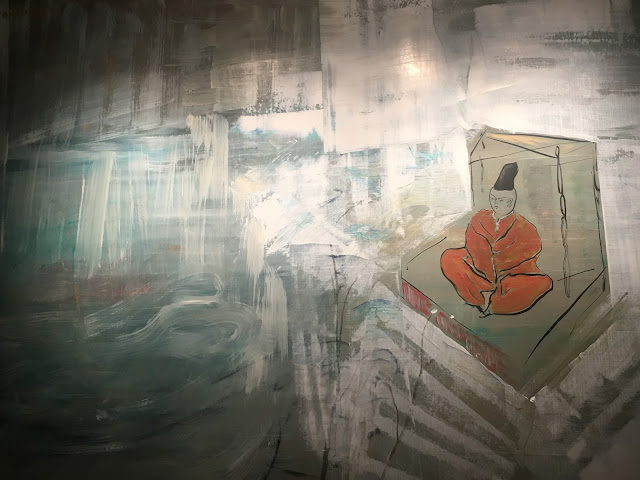In a house in Dallas, Texas a large painting by Texas artist Bill Komodore (1932-2012) hangs in the living room. It was painted in 2012: a swirling, yet calm composition presenting the image of a small figure in Lotus Pose on a platform under a structure.
Bill, originally from Athens, Greece and schooled at Tulane, was a professor of painting at Southern Methodist University for many years: taking in culture and experiences and sending them back into the world through his brush, paint and canvas.
This work, painted the year of his death, is inspired by another work: An Exiled Emperor on Okinoshima painted during the Momoyama period in Japan around the year 1600. The screen is on display as part of the current installation in the Asian galleries at the Kimbell Art Museum in Fort Worth, Texas. (note the wonderful audio tour from my friend Jennifer Casler Price on the work on the Kimbell's website)
The Emperor is likely the Emperor Godaigo (in power 1318-1339). Godaigo's life was written in a fourteenth century account in the text Masukagami, written 1180-1333.) He spent a year in exile after being accused of treason, and after sitting for four long seasons, escaped in a small fishing boat with help from a loyal associate, Takaoki Chidane.
In Komodore's new art history of Godaigo's year of contemplation, we see less details from this story of isolation and waiting. Komodore did not include the story cues of waves, gate and fisherman, or the somber hues of ink and paper: his canvas has all of these things, just through a bolder palate: the nuance of water swirling around the emperor, the sense of isolation, but not being truly alone. Here is a Texan, inspired by a masterwork painting at the Kimbell Art Museum: one that tells a story in 1600 of an event that happened almost three centuries prior, re-immortalized in a contemporary art collection in Dallas, Texas.
This new work is very much a metaphor of how Asia occurs for us in Dallas in 2017.
We see things: screens at the Kimbell, jades at the Crow, Meiji bronzes at the Dallas Museum of Art, and we, as the viewer, assimilate that learning in new contexts of Asian Art History.
Asia is no longer a place inside of lines on a map. It is of the world.
Our work is to slow down, look closely and study. To sit, like this Emperor, for a time, and take it all in. This role as "interpreter" is both an offering and a responsibility: a responsibility to be authentic and sensitive. This role as "interpreter" asks us to listen: to the waves, the crane at water's edge, to the hum of lohans meditating in the wilderness in a jade miniature mountain.
In the listening, in the silence, like the Emperor Godaigo, we hear the moment when it's time to stop sitting and create the next amazing action of our lives.

No comments:
Post a Comment